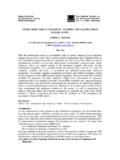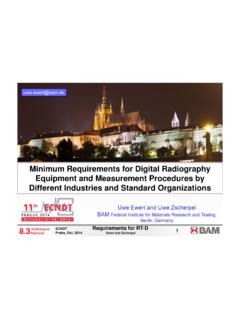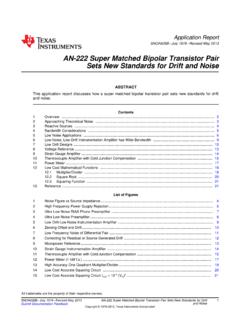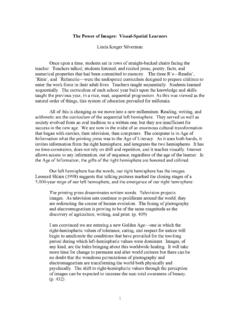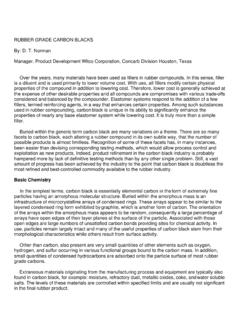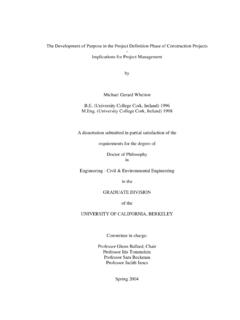Transcription of Use Of Long Range Ultrasonic Testing (LRUT) …
1 Proceedings of the National Seminar & Exhibitionon Non-Destructive EvaluationNDE 2011, December 8-10, 2011 INTRODUCTIONLong- Range Ultrasonic Testing (LRUT) is an advanced Non-Destructive Testing . It is one of the fast inspection tools forcarrying out pipeline survey for corrosion and otherdegradation using Ultrasonic guided waves. LRUT has beendeveloped to detect metal loss in piping. It is a pulse-echosystem, aimed at Testing large volumes of material from a singletest point. The technique was initially developed for detectingCorrosion under Insulation (CUI) for piping in petrochemicalplant. Subsequently, it has found widespread use in otherinspection situations where pipes or tubes are normally notaccessible, viz.
2 Pipes buried in soil, encased in a sleeve orlocated at high elevation and heater aim of LRUT is to test long lengths of pipe rapidly with100% coverage of pipe wall and to identify areas of corrosionor erosion for further evaluation using other NDT techniquessuch as radiography or conventional Ultrasonic inspection. Thetechnique is equally sensitive to metal loss on both outsideand inside surfaces of OF OPERATIONLRUT employs low frequency guided waves, operating justabove audible frequencies, propagated from a ring ofUSE OF LONG Range Ultrasonic Testing (LRUT) TECHNIQUE FOR HEALTHASSESSMENT OF CRITICAL PIPING IN LPG SERVICE IN A PETROLEUM Desai, Mahendra Pal, Mayank Banjare, Chandana Nancharaiah, Sushil Guria and Harsh VardhanIndian Oil Corporation Limited, Guwahati Refinery, Guwahati, Assam, India- 781020 ABSTRACTP rocess piping carrying hydrocarbons in LPG service is normally designed for a life span of 15 years.
3 These lines aresubject to corrosion, wear, mechanical pressurization and fatigue stress over a period of time during its operatingperiod. Therefore during the design stage these factors are taken care of during finalizing of the pipe schedule (thickness)considering the cost economics. It is prudent to assess the health of these lines at a set frequency decided by the ownerbased on several considerations like , corrosion rate, statutory legislative requirements etc. Once the design life iscrossed the inspection frequency has to be increased further to monitor the pipe health. There are certain sections ofthe pipelines like portions crossing under the road crossing/culverts, underground portion, where online inspectionusing conventional Ultrasonic thickness gauging is not possible.
4 To assess the health of these sections, advanced NDT,LRUT (Long Range Ultrasonic Testing ) was successfully used. LRUT is an Ultrasonic based technique where threeforms of wave modes namely, longitudinal, torsional and flexural travel along the pipe. Defects of all sizes andorientations can be detected by this technique. Remaining life calculation based on API570 and observations of LRUT survey were found to corroborate with each other, accordingly, the LPG line was recommended for replacement atthose : Long Range Ultrasonic Testing (LRUT), Corrosion under Insulation (CUI), Distance Amplitude Correction(DAC), Corrosion Rate (MPY), Retiring Life Assessment (RLA).
5 Transducers fixed around the pipe, photograph These lowfrequencies (in Ultrasonic terms) are necessary to enableappropriate wave modes to be generated. At these frequencies,a liquid couplant between transducers and the surface is notnecessary. Satisfactory Ultrasonic coupling being achieved withPhotograph : LRUT Equipment74 Desai : Proceedings of the National Seminar & Exhibition on Non-Destructive Evaluationmechanical or pneumatic pressure applied to back of thetransducers to maintain contact with pipe surface. Uniformspacing of Ultrasonic transducers around pipe circumferenceallows guided waves to be generated that propagatesymmetrically along the pipe axis.
6 These may be visualized asa circular wave that sweeps along the pipe. Whole pipe wallthickness is excited by the wave motion where the pipe is actingas a wave-guide. Hence, it is termed as guided of these guided waves is governed principally byfrequency of the wave and thickness of the material. Whereverthe wave encounters a change in pipe wall thickness (whetheran increase or a decrease), a proportion of energy is reflectedback to the transducers, thereby providing a mechanism fordetection of discontinuities. In case of a pipe feature such as agirth weld joint, increase in thickness is symmetrical aroundthe pipe, so the advancing circular wave front is also reflecteduniformly.
7 Thus, the reflected wave, consisting predominantlyof the same wave mode as the incident wave, is case of pipe corrosion, decrease in thickness will belocalised, leading to scattering of incident wave (in additionto reflection and mode conversion). Therefore, reflected wavewill consist of the incident wave mode plus the mode convertedcomponents. The mode-converted waves tend to cause the pipeto flex as they arise from a non-uniform source. Presence ofthese signals is a strong indicator of discontinuities such ascorrosion. LRUT is able to detect and distinguish betweensymmetrical and flexural waves and both types are reflections are displayed as rectified signals in AmplitudeVs Distance A-scan display, similar to that used inconventional Ultrasonic inspections, but with a time-basedrange measured in tens of meters rather than major complication for guided wave systems, as distinctfrom conventional Ultrasonic inspections is the dispersivenature of guided waves; that is to say, velocity for most of theguided waves varies with frequency.
8 This causes a variety ofcomplications, one being that to calibratetime base of the A-scan to read distance and not time, requiresa computer program to read in a velocity for the selected testfrequency from a calibration, or dispersion curve. There is alibrary of dispersion curves built into the LRUT software fora Range of pipe diameter / wall-thickness combinations. Girthwelds in pipe produce dominant signals in A-scan and act asimportant markers, used to set a Distance AmplitudeCorrection (DAC) curve on display with which signals fromanomalies can be PHILOSOPHYLRUT does not provide a direct measurement of wallthickness, but is sensitive to a combination of the depth andcircumferential extent of any metal loss, plus the axial lengthto some degree.
9 This is due to the transmission of a circularwave along the pipe wall, which interacts with the annularcross-section at each point. It is the reduction in this cross-section to which the guided wave is 1: Guided wave response obtained in 2: Sensitivity to loss of cross sectionFig. 3: LRUT A-scan DAC curves showing different amplitude 2011, December 8-10, 201175 Figure 2 illustrates that the technique is sensitive to flaw areaas a proportion of the pipe-wall is equally sensitive to internal and external flaws. The effectof multiple flaws is OF LRUT INDICATIONSLRUT indications were primarily categories 1, 2 & 3 as Minor , Moderate and Severe , in terms of amplituderespectively.
10 Distance amplitude curves (DAC) weresuperimposed on the LRUT indications for 1 (Green): Responses lower than -26dB line,Estimated cross sectional area wall loss in the Range of 3% to9% (formerly Minor).Category 2 (Red): Responses above the -26dB line, but arelower than blue line at -20dB (formerly Moderate), Estimatedcross sectional area wall loss in the Range of 9% to 15%.Category 3 (Blue): Responses exceeding -20dB blue line,Estimated cross sectional area wall loss > 15%.LRUT REPORT & OBSERVATIONS:Table 1 : LRUT indicationDistanceIndicationPriorityAppr oxrelative toDescriptionThickness datum. (mm) 4: Isometric sketch of Dia.



